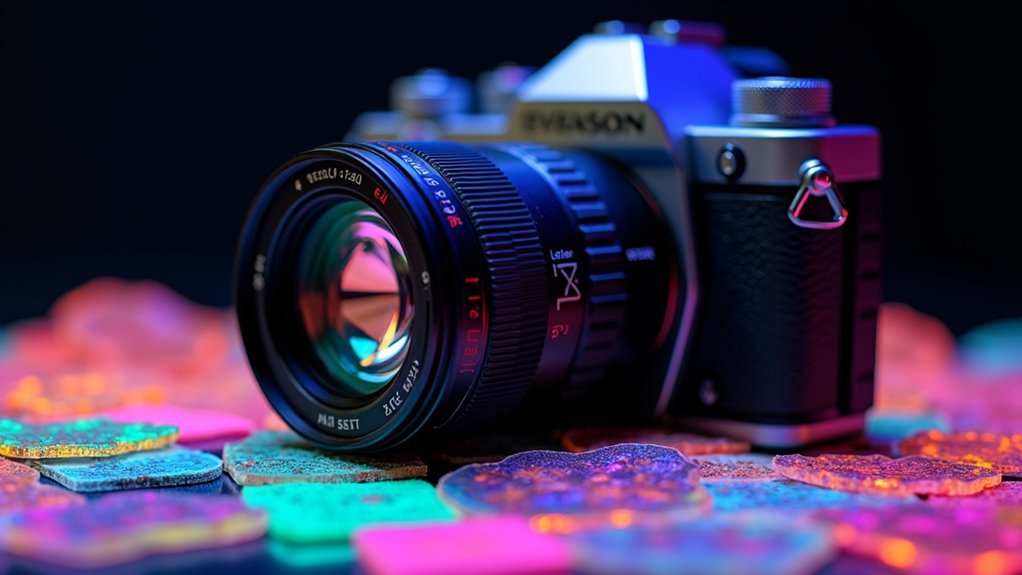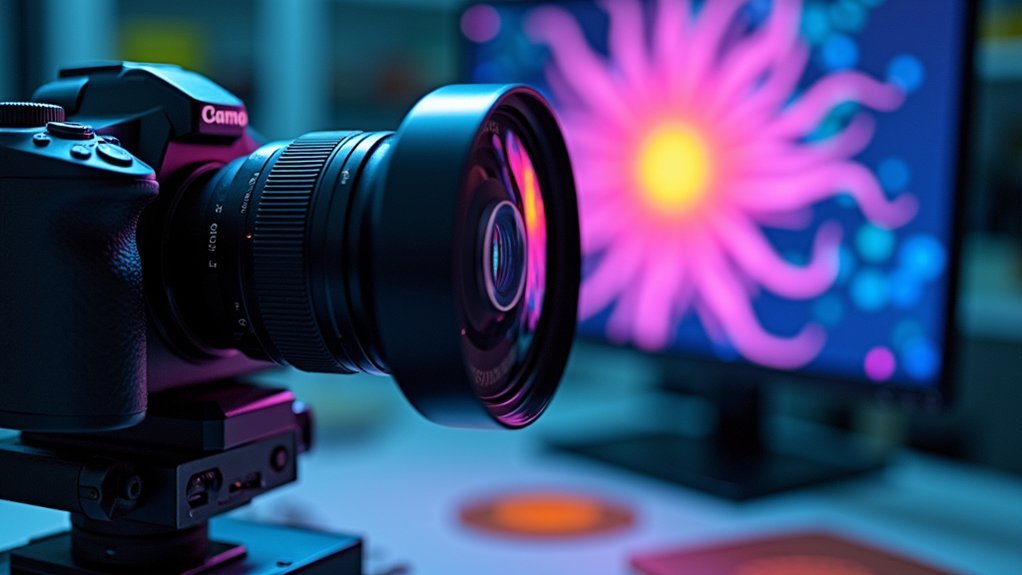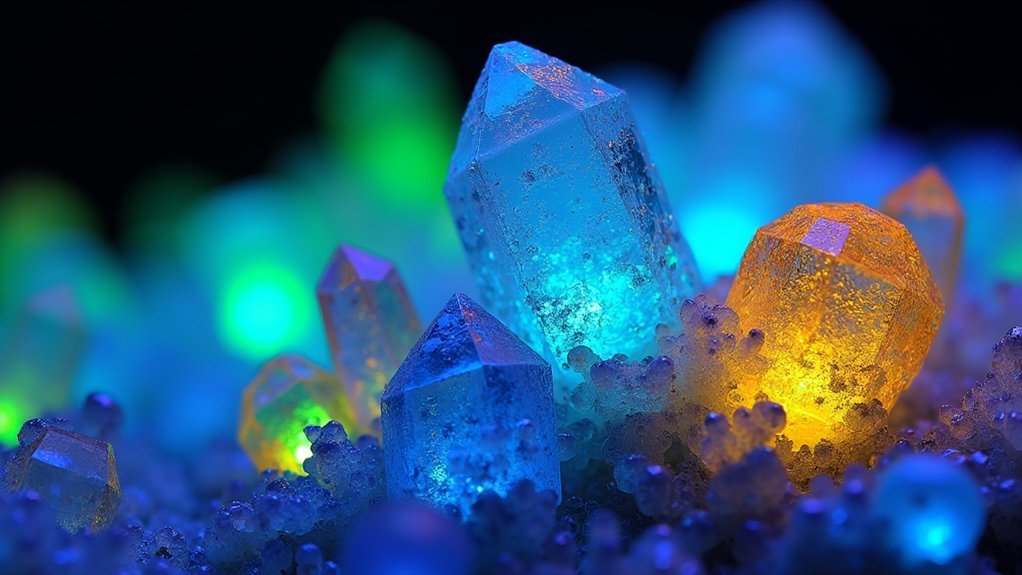For crystal-clear fluorescence images, choose EMCCD cameras for their superior low-light performance and single-photon detection capability. sCMOS cameras offer an excellent balance of speed and sensitivity with high quantum efficiency. Consider the monochrome Axiocam 820 for detailed static samples or Axiocam 807 for dynamic specimens. Always prioritize cooled cameras to reduce noise during long exposures. Your specific application requirements will determine which features matter most for your fluorescence imaging success.
Understanding Camera Technology for Fluorescence Imaging

The journey into fluorescence imaging begins with selecting the right camera technology. Your success depends largely on how well your camera sensor captures faint fluorescent signals while minimizing background noise.
CCD cameras offer reliable black and white imaging, while EMCCDs excel in low-light conditions by amplifying electrons before readout. For dynamic specimens, sCMOS cameras provide faster frame rates with individual pixel amplifiers, delivering high signal-to-noise performance.
Quantum Efficiency is essential—higher QE means more photons convert to detectable electrons, creating clearer fluorescence images. Consider cameras with cooled sensors and low noise electronics to enhance sensitivity in challenging applications.
You can also employ binning techniques to combine adjacent pixels, boosting signal strength, though this trades spatial resolution for improved detection of weak fluorescent signals.
Essential Camera Features for Detecting Faint Fluorescent Signals
When hunting for elusive fluorescent signals, your camera’s sensitivity becomes the paramount consideration in producing meaningful scientific data. High sensitivity enhances your signal-to-noise ratio, letting you visualize structures that would otherwise remain invisible.
| Feature | Why It Matters |
|---|---|
| Monochrome cameras | Higher sensitivity without color filter interference |
| Cooling system | Reduces dark noise that masks faint signals |
| Extended exposure | Increases photon collection for dim samples |
| High QE sensors | Converts more incoming photons to electrical signals |
You’ll notice markedly improved results with cooled cameras, as they minimize thermal noise that can drown out weak fluorescence. Don’t underestimate the advantage of longer exposure times – they’ll dramatically boost your signal-to-noise ratio when working with delicate specimens that emit minimal light.
EMCCD Cameras: The Gold Standard for Low-Light Applications

Among all high-sensitivity cameras, EMCCD (Electron Multiplying Charge-Coupled Device) technology represents the pinnacle of fluorescence imaging performance in challenging low-light conditions.
You’ll achieve unprecedented image clarity when working with weak fluorescent signals thanks to EMCCD cameras’ ability to amplify electrons before readout.
What sets these devices apart is their exceptional signal-to-noise ratio, far surpassing conventional CCDs.
When you’re capturing single-molecule events or conducting live-cell imaging, this advantage becomes critical.
The on-chip multiplication gain enables detection of even single photons, pushing low-light imaging capabilities to theoretical limits.
For researchers tracking fast dynamic processes, EMCCD cameras offer high frame rates while maintaining low read noise—a combination that delivers high resolution fluorescence imaging even in the most demanding applications.
Scmos Innovations: Balancing Speed and Sensitivity
sCMOS cameras revolutionize fluorescence imaging with their unique sensor architecture that places individual amplifiers at each pixel.
You’ll benefit from their remarkable balance of low noise and high frame rates, perfect for capturing dynamic cellular processes that EMCCD cameras might miss.
Their sophisticated pixel-level electron handling enables precise detection of faint fluorescence signals while maintaining exceptional clarity across varying light conditions.
Revolutionary Sensor Architecture
The evolution of imaging technology has reached new heights with revolutionary sensor architecture found in scientific CMOS cameras. When you’re capturing fluorescence images, you’ll appreciate how each pixel has its own amplifier, dramatically boosting frame rates and signal-to-noise ratios on your fluorescence microscope.
What sets sCMOS cameras apart is their exceptional quantum efficiency—they convert more photons into electrons, giving you clearer images even in dim conditions. Unlike older CCDs, these sensors minimize read noise during charge transfer, making weak fluorescence signals visible.
You’ll benefit from the expansive dynamic range and large field of view without sacrificing spatial resolution. The architecture also enables shorter exposure times while maintaining sensitivity, perfect for capturing fast-moving samples or dynamic biological processes.
Low-Noise High-Speed Imaging
When researchers need to capture fleeting biological interactions, the revolutionary low-noise capabilities of scientific CMOS technology become invaluable.
You’ll find that sCMOS cameras deliver exceptional performance in low-light fluorescence imaging through individual pixel amplifiers that maintain sensitivity while boosting speed.
With lower read noise than traditional CCDs, you’re able to detect even the faintest fluorescence signals with remarkable clarity.
These cameras excel at balancing speed and sensitivity—critical when you’re tracking rapid cellular processes in real time.
Consider these key advantages:
- Frame rates exceeding 100 fps for capturing dynamic processes
- 2×2 pixel binning options to enhance signal-to-noise ratio when speed is prioritized
- High-speed imaging without compromising the ability to detect subtle fluorescence changes
Pixel-Level Electron Handling
At the heart of modern fluorescence imaging advancements lies pixel-level electron handling, where sCMOS technology truly differentiates itself from conventional sensors. Each pixel in your sCMOS camera contains its own amplifier, enabling faster readout while maintaining exceptional sensitivity when capturing fluorescent samples.
You’ll appreciate how this architecture greatly enhances signal-to-noise ratios, making even weak fluorescence signals visible in challenging low-light conditions.
When you need higher frame rates, the 2×2 pixel binning option combines four pixels into one super pixel without drastically compromising image quality or high resolution capabilities.
The improved quantum efficiency means your camera converts more photons to electrons, producing clearer, more detailed fluorescence images.
This perfect balance of speed and sensitivity makes sCMOS cameras ideal for capturing dynamic cellular processes where every photon counts.
ZEISS Axiocam Series: Specialized Solutions for Scientific Research
Renowned for exceptional image clarity, ZEISS Axiocam cameras provide specialized solutions for fluorescence microscopy that meet diverse scientific research needs.
When capturing fluorescence images, you’ll appreciate the Axiocam 820 mono’s high-resolution 20 Megapixel sensor designed specifically for low-light conditions, delivering exceptional detail across large fields of view.
For dynamic scientific applications, consider these key options:
- The Axiocam 807 mono offers 7 Megapixel resolution for real-time live cell imaging
- The Axiocam 820 color delivers true color at 20 Megapixels for accurate specimen documentation
- All models integrate seamlessly with ZEISS Labscope and ZEN software for efficient workflow
Whether you’re documenting fast cellular processes or requiring true color digital camera output, the ZEISS Axiocam series provides tailored fluorescence imaging solutions for your specific research requirements.
Camera Cooling Systems: Impact on Image Quality and Signal-to-Noise Ratio

Because fluorescence imaging often involves capturing extremely faint signals, the cooling system in your camera represents a critical component for achieving high-quality results.
Peltier cooling technology can reduce noise levels up to 100 times compared to uncooled systems, dramatically enhancing your image clarity in low-light conditions.
When you’re working with weak fluorescence signals, the cooled image sensors effectively mitigate dark current noise—a persistent challenge during long exposures.
This preservation of signal-to-noise ratio means you’ll capture sharper details and improved contrast, even in the most challenging imaging scenarios.
Selecting the Right Camera Based on Your Specific Fluorescence Application
With the importance of cooling systems established, let’s focus on matching your camera to your specific fluorescence needs. Your application requirements should drive your camera selection, balancing resolution, sensitivity, and speed.
For low-light applications, consider the Axiocam 820 mono with its impressive 20 Megapixel high resolution, capturing fine details in fluorescence images with exceptional clarity.
If you’re working with dynamic samples, the Axiocam 807 mono delivers excellent live image capabilities with its faster frame rates.
- Sample brightness – Dimmer samples require more sensitive cameras with longer exposure time capabilities
- Movement speed – Fast-moving specimens need cameras with quick frame rates
- Color requirements – True color reproduction demands specific fluorescence cameras like the Axiocam 820 color
Frequently Asked Questions
What Camera Is Best for Fluorescence Microscopy?
For fluorescence microscopy, you’ll want a monochrome camera like the Axiocam 820 mono. It’s highly sensitive in low light with 20MP resolution. EMCCD cameras are best for extremely weak signals.
What Kind of Microscope Is Used for Fluorescence Imaging?
For fluorescence imaging, you’ll need an epifluorescence or confocal microscope equipped with specific light sources, filters, and high-NA objectives. These allow you to excite fluorophores and capture their emitted light efficiently.
What Is Fluorescent in Camera?
In a camera, fluorescence refers to the ability to capture light emitted by samples after they’ve been excited by specific wavelengths. You’ll need high sensitivity and low noise to detect these faint signals effectively.
Which Camera Is Used in a Microscope?
You’ll find CCD, EMCCD, sCMOS, and SLR cameras used in microscopes. For fluorescence imaging, cooled monochrome cameras like Axiocam 820 mono are ideal, while USB or HD cameras work well for basic applications.
In Summary
You’ve now explored the critical elements in selecting the perfect camera for fluorescence imaging. Remember, your application’s specific needs should guide your decision—whether you need the ultra-sensitivity of EMCCDs, the versatility of sCMOS, or the specialized capabilities of the ZEISS Axiocam series. Don’t overlook cooling systems that’ll dramatically improve your image quality. With the right camera, you’ll capture those elusive fluorescent signals with remarkable clarity.





Leave a Reply